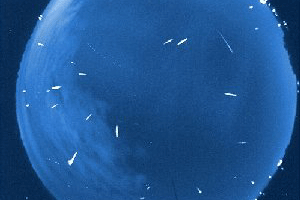Then, suddenly, I saw a star-like pinpoint of light flash into existence, and then out again, gone in the time it takes a star to twinkle once (maybe a half second or less). Wondering if it was a high altitude airplane's head or tail light or a satellite turning and flashing in the sunlight high above, I kept watching, expanding my area of focus to keep it in sight as it moved. But, not only did I find it had not moved much when the flash did reoccur, it in fact had not moved at all: the same point in the sky, not far from a pair of stars in Pegasus, issued the same quick, star-like flash.
Now quite intrigued, I glued my eyes on Pegasus. In the next five minutes or so, I saw five or six more flashes. A couple times they were in the exact same spot as the first two, but in other cases they appeared in different parts of Pegasus, though not far from original location; all of the flashes occurred in an area of the sky smaller than my fist held at arm's length.
Then followed my usual process of trying to eliminate suspects. It wasn't an airplane with a flashing tail light or wing lights (at least, not one behaving conventionally): the flashes were not at regular intervals, and did not fall upon a discernible line or arc as the plane moved.
It was not a low-altitude satellite: Even more than airplanes, these must travel along a line--so even the ones that appear because they have a reflective surface (like a solar panel) and are flashing us as they rotate will appear as a string of flashes, not a cluster of flashes of random brightness and with random and repeating positions. What I saw more resembled the flash pattern of a cloud of broken glass fragments falling in sunlight, almost like glitter.
Iridium satellites exhibit flashes as they turn in the Sun—you can even find out when and where they are going to occur. But Iridium flares occur as a single, relatively slow flash, with evident motion, and they don't occur in clusters.
Very high altitude satellites—those far enough from Earth as to appear motionless—are too far away to normally be visible to the eye. But what about a rotating high altitude satellite with reflective surfaces? Maybe...but again, why a cluster of them? What conditions would make this possibility ripe?
What this left me with, at least on my short list, are point meteors: ones that fly directly toward you and so appear as a point-like flash rather than a moving streak. In fact, while I was waiting for more flashes, I noticed two meteors streak away to the north that actually started their flashy flights right in Pegasus. There was even a meteor shower that was just past its peak: the Draconids, aka the Giacominids. The two I saw were traveling more toward Draco, and not away from it.
Coincidence? Well, to draw on one of my favorite quotes, "I believe that coincidences go on all the time. But I don't trust coincidences."
If they were point meteors, then I witnessed a highly improbably event: six or seven of them within a five minute span, and from a spot on the sky that was not currently the radiant point of any annual meteor shower. What was it, then? A new meteor shower? Less than likely considering the time of night and the apparent radiant point—but I won't strike it from my list.
Believe me, I wish I had an answer for you. Others have reported very similar observations, but also don't have a definitive answer. One thing is for certain: in the future, I will answer other people's questions about "what was that thing I saw in the sky?" with a somewhat more sympathetic predisposition….
37.8148 -122.178
 Wide-angle, long exposure of a meteor shower."I was visiting my parents, and around ten o'clock I went outside to take a look at the stars, looked straight up—and I saw a strange flash of light. Did I see a UFO?"
Wide-angle, long exposure of a meteor shower."I was visiting my parents, and around ten o'clock I went outside to take a look at the stars, looked straight up—and I saw a strange flash of light. Did I see a UFO?" 